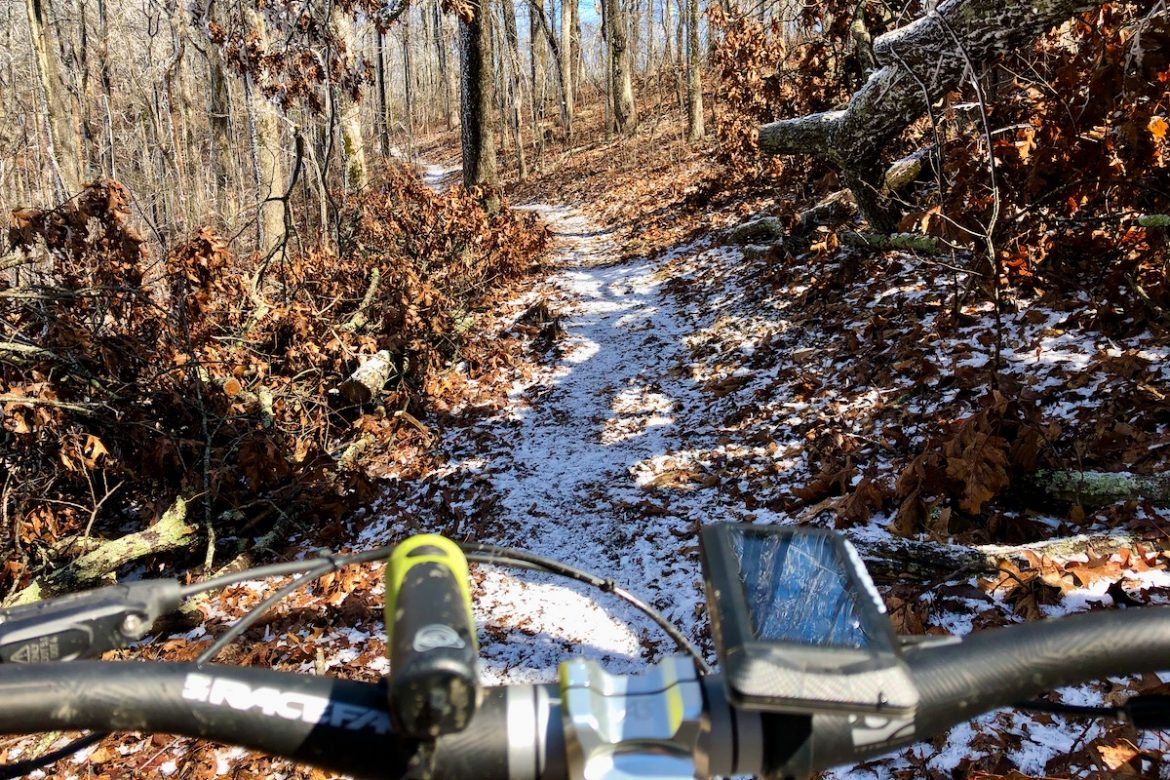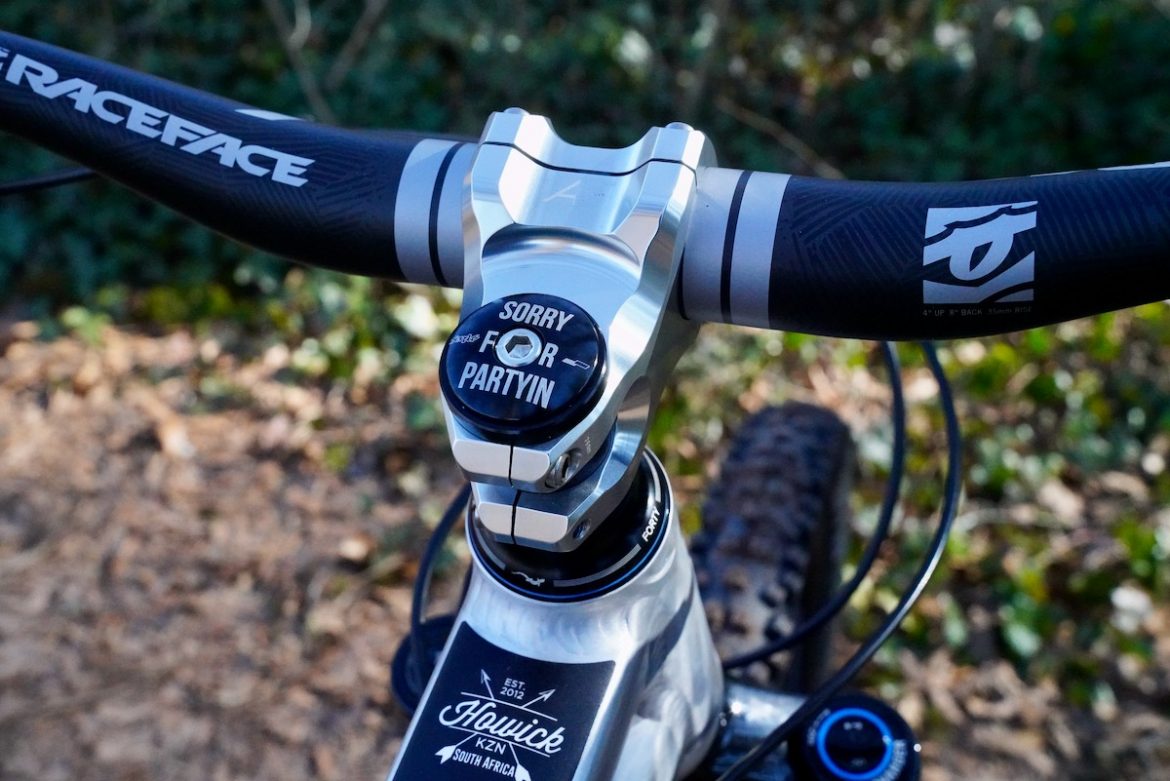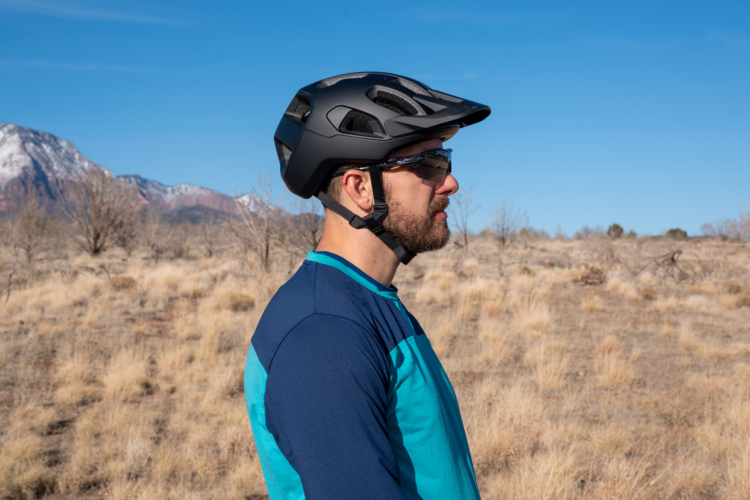
Be sure to read our in for test article about the Pyga Hyrax for full specs and additional photos.
All-mountain is a mountain bike term that doesn’t get enough play, in my opinion. Brands seem to have settled on using trail and enduro to describe models, but what to call something that sits close to the line between the two? Aggressive trail and enduro lite just don’t seem to capture what these bikes are truly capable of, which is to ride all of the mountain. Or maybe it’s all of the mountain bike trails.
Pyga embraces the all-mountain label for the Hyrax, and I’ve been testing the bike for several weeks this winter. Despite the pandemic and the weather, I’ve managed to notch a variety of rides aboard the Hyrax, and it’s left me suitably impressed.
Putting the mountain in all-mountain


Stanley Gap is known as one of the more challenging mountain bike trails in Georgia. Despite a dusting of snow and a couple of slick spots where the trail bends into the wrinkles and folds of the mountain, I absolutely charged down the trail on the Hyrax in February. Thanks to the heavy-duty, wide tire up front and the progressive suspension platform, there was little need to hem and haw over line selection through the fastest and rockiest, root-clogged sections. Harder-hitting riders will no doubt want to upgrade the 2.4-inch, WTB Ranger with Light casings to something burlier for added insurance.
It’s been years since I’ve ridden the Stanley Gap trail, so in many ways, I was riding it sight-unseen. Yet I felt confident to ease off the brakes and generally aim for the centerline, figuring the Hyrax would keep me rolling even if things ended up being more complicated than they appeared from a distance.


The Hyrax tends to hug the ground a bit more than some bikes, for a grounded, racy feel. At the same time, there’s plenty of pop in the suspension to play off rocks and roots. At 140mm of travel in the rear, there’s definitely a limit to the size of jumps and drops the suspension can handle. I did bottom out the RockShox Deluxe Ultimate shock a time or two, and fortunately the suspension ramps up nicely at the end of the stroke to take most of the sting out of the return to earth.
Although Stanley Gap is often ridden as an out-and-back, I decided to ride it as a loop in order to include more of the Aska system singletrack. Unfortunately, that means a good bit of climbing on the pavement, then a gravel road, and finally singletrack. The meaty, 2.5-inch WTB Vigilante with “Tough” casing up front is noticeably slow-rolling on any surface that doesn’t point downhill, so much so that it feels like the bike loses all momentum as soon as I ease off the pedals. Yet, steep and out-of-the-saddle climbs aren’t noticeably mushy or bobby thanks to the tried-and-true Horst-link design. Weighing just shy of 32lbs. the bike surprisingly doesn’t suffer the climbs any more than the many carbon wonder-bikes I’ve tested.
I have to say I wasn’t surprised to see the Hyrax perform well on Stanley Gap. Pyga boasts that the bike will be “at home on the majority of enduro race tracks,” and this trail, with its long, uninterrupted descents, mostly open sightlines, and a sufficiently wide corridor is about as enduro as it gets, at least for the East Coast. Sweep back some of the leaves and dry the dirt out a bit, and you could find a trail like this in Colorado or California; design and market a bike for this type of trail, and you’ve got a winner in the biggest mountain bike markets in the USA. But for a bike to truly call itself all-mountain, it should also be able to ride just as confidently on other types of trails.
Slow, tech

I rode the Hyrax on another most-difficult-rated trail here in Georgia, which is tough for entirely different reasons. There’s not a lot of speed involved, but there are rocky sections on the newest trail at Southside Park — located just east of Hartsfield-Jackson International, the world’s busiest airport — that will make a grown man or woman cry. These are wheel-sucking, momentum-arresting, and soul-crushing rock gardens the likes of which are usually limited to trails in the Northeast that few will ride more than once, just to say they did it. Or maybe that’s just me.
The advanced loop at Southside has a lovely flow section in the middle that the Hyrax absolutely slays. Admittedly, I kinda just tolerate the crying rocks so I can get to the good stuff, but the Hyrax had me volunteering for more of the slow, techy gnar. On one dawn-patrol ride, I rode the advanced loop clockwise, and rather than wiping my brow and patting myself on the back for cleaning the rocky bits from start to finish, I decided to go back around counter-clockwise for round two with the rocks.
There are a few things that make mid-travel, or aggressive-trail, or whatever-you-want-to-call-them, bikes draggy in slow tech. Depending on the progression curve, some bikes can feel too soft and bouncy at the top of the stroke. The Hyrax gets the balance right, delivering a responsive pop when it’s time to put down power, whether that’s muscling over a big rock or accelerating out of a turn.
The no-nonsense aluminum frame is predictably stiff, both vertically and laterally. Overall this delivers a consistent platform for pushing and pulling, especially in tight situations.
Geometry also plays an important role in navigating techy trails, and thankfully trail bikes are better than ever in this regard. The Hyrax pairs a 66° head tube angle with a 77.3° seat tube angle and 480mm reach (size large) to balance the rider in the sweet spot for stability. In practice the front end stays planted while keeping enough weight on the back wheel to maintain traction through the trickiest climbs. The higher than average 345mm bottom bracket height (high position, tested) has proven to offer excellent clearance over logs and rocks.
Getting local

If you’ve ever found yourself riding a game trail, either by accident or on purpose, then you have some sense of what my local trails are like. We’re talking ribbons of singletrack less than a foot wide, and trees so close together that both ends of the handlebars will scrape. Most mountain bikes just aren’t designed for these types of trails, probably because few will choose to ride them (the trails or the bikes). I know this because I rarely see anyone riding the trails I’m talking about.
So whether out of boredom or skeptical curiosity, I decided to test the Hyrax on some of my local trails to see how it would fare. The 820mm bars are clearly not ideal, and I can count on one hand the number of places where I might be able to use all 150mm of the fork travel. There’s so much pedaling involved — mostly to maintain momentum through the rough and twisty stuff — that the Pyga Hyrax is the definition of overkill. Locals tend to keep a hardtail in the garage for the in-town trails, and a bike like the Hyrax for riding in the mountains.
By now you probably see where I’m going with this, but I’ll go ahead and say it: The Hyrax was a blast on my local trails too. All the things I figured would be buzzkills — wide bars, slow tires, generous suspension travel — turned out to be minor trade-offs. In fact, I’d say the bike managed to squeeze even more fun out of the trails. This particular build features a 210mm OneUp dropper post which makes it easy to go from efficient pedaling to super low and ducky in an instant. The composed suspension smoothes rough, janky trails at higher speeds than I’m used to and still holds enough pre-load to get air off the rocks and roots I usually ignore.

Local trails also tend to offer steeper, more off-camber bits than standard trail fare, and again, the balanced geometry shines here too. The front wheel tracks as precisely as you like, and the long dropper bailed me out on more than one occasion when things turned sketchy.
Rear tire clearance is nice and open, and the lower pivot clears trail crud well.
Ride notes

It should be clear by now that the Pyga Hyrax is more than justified in claiming the title “all-mountain.” This particular test build comes with a few unique parts selections that are worth noting.
In the on-test article, I mentioned that I might swap out the oval chainring for a standard round one. After my first big test ride, I really didn’t notice the oval ring — good or bad — so I decided to stick with it for the duration of the test. In the past I’ve found oval rings to suffer in particularly technical sections where pedal timing is everything. Despite riding some truly nasty stuff during my test, I had zero issues.
As a big-handed rider, I figured I would enjoy the 35mm diameter Meaty Paw grips. This was my first experience with anything other than a standard-diameter grip, and initially I did find some discomfort, particularly when wearing thick, winter mtb gloves. On warmer days I was able to ride without gloves, and that turned out to be the ticket. As glove-free grips, these big boys work well. They give the bike an overall burlier and more in-control feel, which is great. I just might prefer to run these in the summer, and switch back to regular grips for winter-glove season.

The Hyrax is nice and quiet on the trails. Apart from the deep, buzzy Industry Nine 1/1 hub, there’s no cable rattle or chain slap to harsh those blissful freewheeling moments. The build is dialed, and it’s clear this bike was expertly assembled by the folks at Pyga USA.
Bike of the year, in March?
I completed the bulk of my test rides by the end of February, and I have a feeling the Pyga Hyrax will be a tough one to beat for my best of 2021 list. At the end of last year, the Canyon Spectral was among my favorites, offering a similar amount of travel with its aluminum frame. Weighing a couple of pounds less and riding just as well if not better, I’d give the Hyrax an edge over that bike, but to be fair it costs twice as much as the Spectral. While this exact build is not on offer, complete bikes are priced between $4,199 and $5,399.

It’s hard to ask more of a mountain bike than to be able to tackle most, if not all, of the trails I want to ride during the year. The Pyga Hyrax has proven itself to be just that type of animal.
About the Pyga Hyrax

Pyga is a South African mountain bike brand that got its start in 2010 when founder Patrick Morewood moved on from his eponymous gravity bike brand to make a fresh start. The company designs and builds straightforward, full suspension mountain bikes primarily for racing, but with an eye toward the everyday rider as well. Buyers won’t find gravel bikes or even a hardtail in the brand’s current line up, leaving the relatively small Pyga team to focus on creating fast bikes for rough courses.
I tested the brand’s “all-mountain mid-travel smash machine,” called the Hyrax. This alloy bike is offered as a frame-only, or with one of two builds which can be customized based on the buyer’s preferences. The builds on offer clearly reflect Pyga’s race-first, party-second philosophy, giving buyers the choice of a competition-worthy X01 setup, or an every-person, GX-equipped build. My test bike leans toward the race side, though I most definitely will not be racing this winter, unless you count chasing a few PRs in the mountains.

Named for the rock hyrax, also known as a rock rabbit, the Pyga Hyrax is a 140 travel bike with a 150mm fork, designed to be as fast and as sure-footed as its namesake across challenging lines. Hyrax — the critter, not the bike — is also considered to be a minor pest, so getting to know this bike’s trail personality should be interesting.
The frame



The 29er Pyga Hyrax starts with a 6066-T6 aluminum alloy frame, and the bike I’m testing features a beautiful raw aluminum finish. Internal cable routing keeps the lines nice and neat, and there’s even a port on the right side for those who run their brakes moto, or racers looking to route a shock lockout remote cable. This size extra-large frame has more than enough room for a giant water bottle.
Starting at the top and front of the bike, the Hyrax sports a 66° head tube angle, which can be slackened half a degree to 65.5° by flipping a chip at the lower shock mount. This also serves to drop the bottom bracket by 5mm, from 345mm to 340mm.

The 77.3° effective seat tube angle isn’t the steepest, but it should be plenty to keep the 66° front end planted when the trail turns uphill. Size large Hyrax bikes have a 480mm reach and all sizes feature 435mm-long chain stays.
| Small | Medium | Large | Extra Large | ||
|---|---|---|---|---|---|
| Seattube | A | 400mm | 430mm | 470mm | 520mm |
| Toptube | B | 555mm | 590mm | 622mm | 655mm |
| Headtube Angle (High) | C | 66deg | 66deg | 66deg | 66deg |
| Headtube Angle (Low) | C | 65.5deg | 65.5deg | 65.5deg | 65.5deg |
| Chainstay | D | 435mm | 435mm | 435mm | 435mm |
| Wheelbase | E | 1173mm | 1208mm | 1233mm | 1263mm |
| Actual Seattube Angle | F | 70deg | 70deg | 70deg | 70deg |
| Virtual Seattube Angle | G | 77.3deg | 77.3deg | 77.3deg | 77.3deg |
| BB Drop (High/Low) | H | 29mm/24mm | 29mm/24mm | 29mm/24mm | 29mm/24mm |
| BB Height (High) | I | 345mm | 345mm | 345mm | 345mm |
| BB Height (Low) | I | 340mm | 340mm | 340mm | 340mm |
| Headtube Length | J | 95mm | 105mm | 115mm | 130mm |
| Reach | K | 420mm | 445mm | 480mm | 510mm |


The Hyrax uses a metric trunnion shock mount and is compatible with both air and coil shocks. Home mechanics will also be stoked to know the Hyrax comes with a threaded bottom bracket.
The rocker and rear brake mounts are built with machined aluminum, adding to the bike’s precision-crafted aesthetic.


The boost rear end is said to be 27.5+ compatible with tires up to 2.8″ wide. The included 2.4-inch 29er rear tire leaves good clearance and suggests the potential to possibly go another tenth of an inch wider.
Without pedals, my extra large test bike weighs 31.8lbs. While the exact build I’m testing doesn’t match up with either of those currently on the Pyga website, the closer match retails for $4,899.
The build



This Hyrax build comes with a 150mm RockShox Pike Ultimate fork and a RockShox Deluxe Ultimate shock. The brakes are SRAM Code RSC and the whole thing rolls on Industry Nine Enduro S alloy wheels. A 34.9mm diameter OneUp dropper post with 200mm of travel serves to get the Ergon SMC men’s saddle out of the way when it’s time to drop in.
A SRAM XX1 Eagle crankset is mixed with an X01 derailleur and this build features a 32-tooth oval chainring. Personally, I’m not a fan of oval rings so I may change this out during my testing.



The cockpit consists of 820mm-wide Race Face SixC carbon bars, mounted with a shiny 50mm Industry Nine A35 alloy stem. Mine shipped with Sensus Kyle Strait Signature Meaty Paw grips with a massive 35mm diameter. I’m a tall rider with large hands, and these feel great, though clearly they won’t be for everyone.


In the tire department, this Hyrax build comes with a 2.4″ WTB Ranger in the rear and a meatier, more aggressive 2.6″ WTB Vigilante in the front.

Overall the build spec looks smart, and the matching silver and gray accents make it clear a lot of thought went into choosing each part.




















2 Comments
Mar 26, 2021
Apr 1, 2021